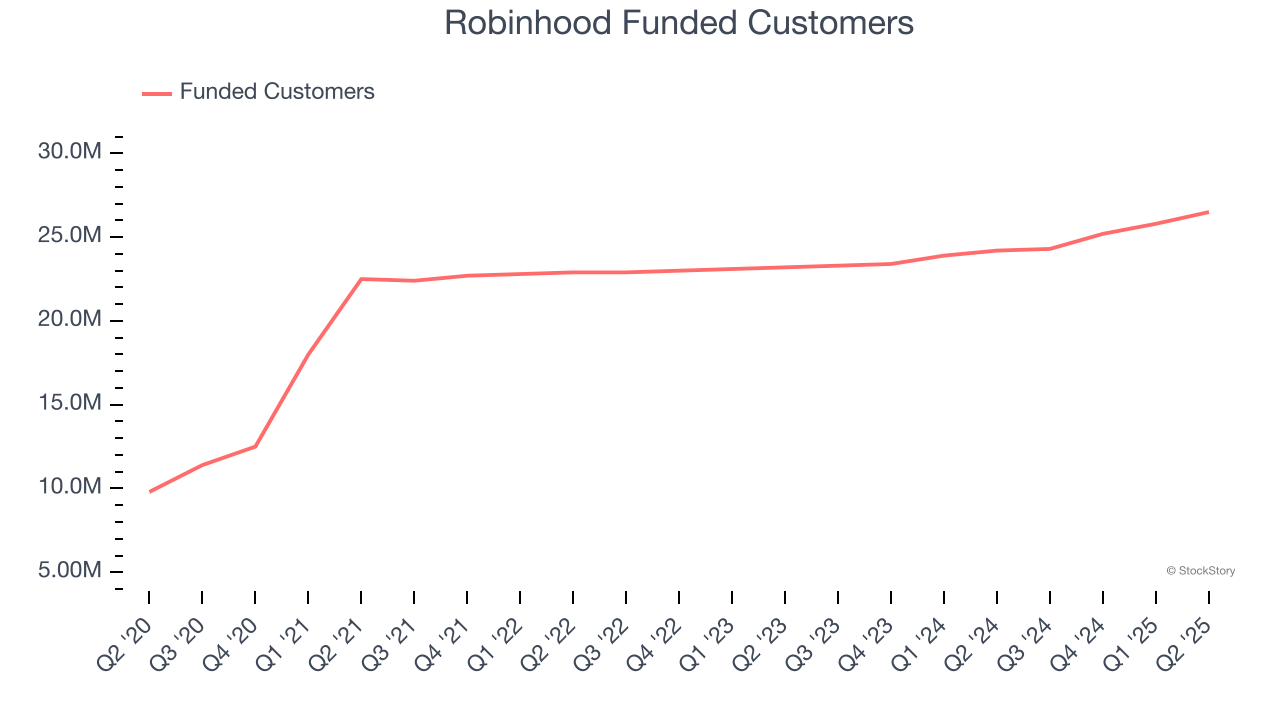
Financial services company Robinhood (NASDAQ: HOOD) reported Q2 CY2025 results topping the market’s revenue expectations, with sales up 45% year on year to $989 million. Its GAAP profit of $0.42 per share was 35.2% above analysts’ consensus estimates.
Is now the time to buy Robinhood? Find out by accessing our full research report, it’s free.
Robinhood (HOOD) Q2 CY2025 Highlights:
- Revenue: $989 million vs analyst estimates of $920.4 million (45% year-on-year growth, 7.4% beat)
- EPS (GAAP): $0.42 vs analyst estimates of $0.31 (35.2% beat)
- Adjusted EBITDA: $549 million vs analyst estimates of $448.8 million (55.5% margin, 22.3% beat)
- Operating Margin: 44.7%, up from 27.7% in the same quarter last year
- Free Cash Flow Margin: 353%, up from 68.1% in the previous quarter due to higher
- Funded Customers: 26.5 million, up 2.3 million year on year
- Market Capitalization: $91.17 billion
“We delivered strong business results in Q2 driven by relentless product velocity, and we launched tokenization—which I believe is the biggest innovation our industry has seen in the past decade,” said Vlad Tenev, Chairman and CEO of Robinhood.
Company Overview
With a mission to democratize finance, Robinhood (NASDAQ: HOOD) is an online consumer finance platform known for its commission-free stock and crypto trading.
Revenue Growth
Examining a company’s long-term performance can provide clues about its quality. Any business can have short-term success, but a top-tier one grows for years. Over the last three years, Robinhood grew its sales at an incredible 38.4% compounded annual growth rate. Its growth surpassed the average consumer internet company and shows its offerings resonate with customers, a great starting point for our analysis.

This quarter, Robinhood reported magnificent year-on-year revenue growth of 45%, and its $989 million of revenue beat Wall Street’s estimates by 7.4%.
Looking ahead, sell-side analysts expect revenue to grow 13.6% over the next 12 months, a deceleration versus the last three years. Despite the slowdown, this projection is commendable and suggests the market is forecasting success for its products and services.
Here at StockStory, we certainly understand the potential of thematic investing. Diverse winners from Microsoft (MSFT) to Alphabet (GOOG), Coca-Cola (KO) to Monster Beverage (MNST) could all have been identified as promising growth stories with a megatrend driving the growth. So, in that spirit, we’ve identified a relatively under-the-radar profitable growth stock benefiting from the rise of AI, available to you FREE via this link.
Funded Customers
User Growth
As a fintech company, Robinhood generates revenue growth by increasing both the number of users on its platform and the number of transactions they execute.
Over the last two years, Robinhood’s funded customers, a key performance metric for the company, increased by 5.1% annually to 26.5 million in the latest quarter. This growth rate lags behind the hottest consumer internet applications. If Robinhood wants to accelerate growth, it likely needs to engage users more effectively with its existing offerings or innovate with new products. 
In Q2, Robinhood added 2.3 million funded customers, leading to 9.5% year-on-year growth. The quarterly print was higher than its two-year result, suggesting its new initiatives are accelerating user growth.
Revenue Per User
Average revenue per user (ARPU) is a critical metric to track because it measures how much the company earns in fees from each user. ARPU also gives us unique insights into the average transaction size on Robinhood’s platform and the company’s take rate, or "cut", on each transaction.
Robinhood’s ARPU growth has been exceptional over the last two years, averaging 40.9%. Its ability to increase monetization while growing its funded customers demonstrates its platform’s value, as its users are spending significantly more than last year. 
This quarter, Robinhood’s ARPU clocked in at $151. It grew by 33.1% year on year, faster than its funded customers.
Key Takeaways from Robinhood’s Q2 Results
We were impressed by how significantly Robinhood blew past analysts’ EBITDA expectations this quarter. We were also glad its revenue outperformed Wall Street’s estimates. Zooming out, we think this was a good print with some key areas of upside. The stock traded up 2.1% to $108.36 immediately following the results.
Sure, Robinhood had a solid quarter, but if we look at the bigger picture, is this stock a buy? We think that the latest quarter is only one piece of the longer-term business quality puzzle. Quality, when combined with valuation, can help determine if the stock is a buy. We cover that in our actionable full research report which you can read here, it’s free.





